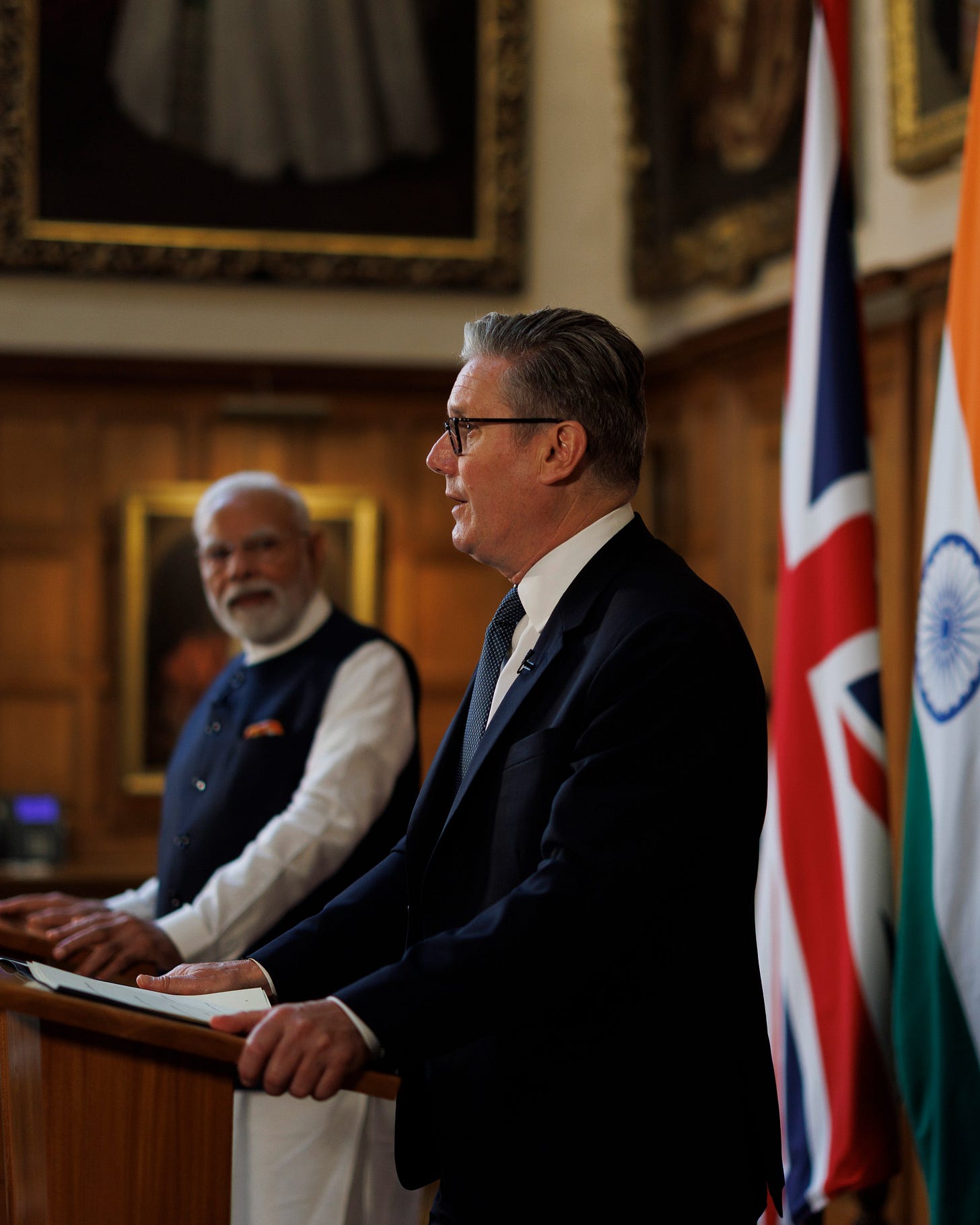A Tale of Two Colonies
The U.K.’s agreement with India mirrors a world still pressing ahead on free trade, even as its deal with America marks a step backwards
Sir Keir Starmer’s visit to India this week could not come at a better time for him. Now officially the United Kingdom’s least popular prime minister ever, with a seventy-nine percent (!) disapproval rating, he will be happy to spend a few days avoiding questions about budget cuts, immigration and political scandal back home, and draw attention to the landmark trade agreement he and Prime Minister Narendra Modi concluded in May.
The contrast between this deal and what Starmer agreed with U.S. President Donald Trump at roughly the same time offers investors an important window into the world’s evolving trading system. While the U.S. has raised barriers to most of its trading partners and continues to brandish tariffs as a universal weapon, other countries continue to negotiate deals that reduce tariffs.
Globalization is not over; it has just become more expensive for Americans. If the country’s protectionist turn has yet to derail the current expansion, the costs in lost competitiveness, political corruption and rising uncertainty are unavoidable.
Consider the differences between the two new agreements that Starmer signed with his country’s two most important former colonies (with apologies to our Canadian friends).
Deals: Starmer’s agreement with Trump, announced unexpectedly in May, is primarily a handshake on a framework that helps narrow the range of differences that remain to be sorted. Meanwhile, after three years of difficult negotiations, the U.K. and India signed a legally-binding agreement that is to be ratified and codified by the two legislatures.
Scope: These two agreements will govern trade flows between the world’s first (U.S.), fourth (India) and sixth (U.K.) largest economies. The third leg of this triangle, between Washington and New Delhi, remains stuck in a weird geopolitical twilight zone as Trump imposed 50% tariffs on most Indian imports until Modi gives up Russian oil purchases.
Tariffs: The U.K. lowered its average tariffs on U.S. goods from 5.1% to 1.8%, while the U.S. has actually raised tariffs on most U.K. imports to 10%. India, a famously protectionist country, has agreed to reduce or eliminate tariffs on 92% of imports from the United Kingdom, resulting in an estimated average tariff reduction from 15% to 3%. Meanwhile, 99% of Indian goods will enter the U.K. tariff-free.
Sectors: For Britain’s deal with the U.S., automotive, aerospace and steel exporters may benefit the most from tariff cuts and quotas that will help undercut their continental European competitors. Pharmaceutical and semiconductor exports should also benefit, although these details have yet to be finalized. By contrast, it may be harder to find sectors that won’t benefit from the comprehensive India agreement. Everything from cars to lamb to perfume will face lower tariffs, and everyone from lawyers to accountants to bankers should see easier market access. British films should expect better copyright protection, too.
Outlook: Britain’s terms of trade with India are expected to improve as some tariff lines are scheduled to fall over time. By contrast, Trump has announced sectoral tariffs on steel, pharmaceuticals and semiconductors that may yet narrow current exemptions in the U.K. framework as negotiations on the details continue.
As Starmer and Modi celebrate their deal and talk up fresh “fintech” partnerships this week, they are hardly alone in breaking down trade barriers as Trump continues to dream up new ones. Canada, Japan, Australia, the European Union and others are all conducting major trade negotiations to reduce tariffs and expand market access. The U.K. has even joined the Comprehensive and Progressive Agreement for Trans-Pacific Partnership (CPTPP) of mainly Pacific Rim economies. This, of course, was the successor to the Trans-Pacific Partnership (TPP), from which Trump withdrew on the first day of his first term.
Globalization is not over; it has just become more expensive for Americans. If the country’s protectionist turn has yet to derail the current expansion, the costs in lost competitiveness, political corruption and rising uncertainty are unavoidable.
It’s too soon to say just what all these bilateral deals will do to the world economy, even as the U.S. erects barriers to trade. It’s too soon to understand the geopolitical consequences of the leading superpower abandoning efforts to build a global system of rules so it can impose lopsided and unpredictable deals on smaller economies.
But it’s not too soon to predict that the United States will bear the costs of its new protectionism. They may not be evident in today’s stock prices or even next quarter’s inflation readings. Imports remain just 14% of GDP, and most trade partners have so far opted against retaliation that might trigger rising inflation expectations.
But history’s lessons are clear that companies with tariff protection grow fat and lazy; lobbyists and politicians thrive on extending tariffs indefinitely; and businesses considering an investment in USA Inc. will balk at the persistent uncertainty around the tariff regime.
America’s self-inflicted woes won’t be high on Starmer’s mind this week. There is too much potential ahead for his country in the India trading relationship, and too much gloom gathering when he returns home.




You should offer some analysis of the two starting points. India is not an open practitioner of free trade. The two deals tell more about how a mid-size country approaches access to two much larger markets at different points of economic maturity.